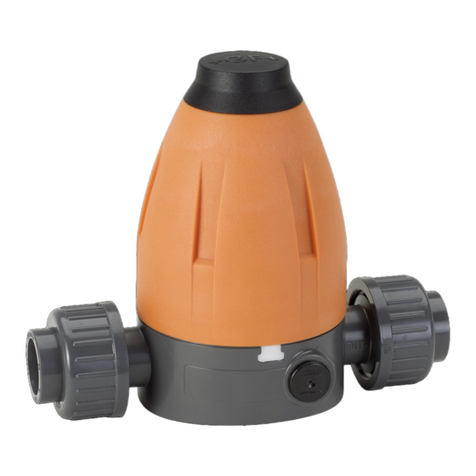
2Signet 4150 Turbidimeter
Refer to your local Georg Fischer Sales office for the most
current warranty statement.
All warranty and non-warranty repairs being returned must
include a fully completed Service Form and goods must be
returned to your local GF Sales office or distributor.
Product returned without a Service Form may not be
warranty replaced or repaired.
Signet products with limited shelf-life (e.g. pH, ORP, chlorine
electrodes, calibration solutions; e.g. pH buffers, turbidity
standards or other solutions) are warranted out of box but not
warranted against any damage, due to process or application
failures (e.g. high temperature,
chemical poisoning, dry-out) or
mishandling (e.g. broken glass,
damaged membrane, freezing
and/or extreme temperatures).
Thank you for purchasing the Signet line of Georg Fischer
measurement products.
If you would like to register your product(s), you can now
register online in one of the following ways:
• Visit our website www.gfsignet.com.
Under Service and Support click on
Product Registration Form
• If this is a pdf manual (digital copy), click here
Warranty Information Disclaimer
4150 Turbidimeter Parts
Product Registration
Safety Information
This manual contains basic instructions that must be followed
during the commissioning, operation, care and maintenance
of the instrument. The safety protection provided by this
equipment may be impaired if it is commissioned and/or used
in a manner not described in this manual. Consequently, all
responsible personnel must read this manual prior to working
with this instrument.
Georg Fischer Signet LLC accepts no responsibility for damage
caused by the introduction of vapors, fluids or other materials
into the instrument process stream which is not compatible with
the wetted materials. A list of the wetted materials can be found
in the specifications on page 3 of this manual.
Material Safety Data Sheets (MSDS) are available online at
www.gfsignet.com
It is the responsibility of the Distributor, Dealer, or Agent to
provide a current copy of the MSDS to the Consumers of
Georg Fischer Piping Systems products. The information
contained herein is presented in good faith and has been
compiled from sources believed to be reliable. It represents the
best information currently available to us. No warranty express
or implied, or merchantability, fitness or otherwise is made and
we assume no liability resulting from its use. This information is
offered for your consideration and users should make their own
investigation and verification to determine the suitability of the
information for their particular purposes. In no event shall
Georg Fischer Piping Systems, the parent company or its
subsidiaries be liable for any claims, losses, or damages of any
third party or for lost profits or any special, indirect, incidental,
consequential or exemplary damages, howsoever arising,
even if Georg Fischer Piping Systems has been advised of the
possibility of such damages. This information relates to the
material designated and may not be valid for such material
used in combination with any other materials nor in any process.
Caution / Warning / Danger
Indicates a potential hazard. Failure to follow all warnings
may lead to equipment damage, injury, or death
Electrostatic Discharge (ESD) / Electrocution Danger
Alerts user to risk of potential damage to product by ESD,
and/or risk of potential injury or death via electrocution.
Do Not Use Tools
Use of tool(s) may damage product beyond repair and
potentially void product warranty.
DO NOT
FREEZE
Do Not Freeze (Calibration Standards)
Products are temperature sensitive and may contain
freezable liquids. Freezing damage voids accuracy.
Unpacking and Inspecting the Instrument and Accessories
The table below indicates the items in the Turbidimeter shipment.
Qty Item
1 3-4150- ( __ ) Turbidimeter
1 3-4150.090 Instruction Manual
1 3-4150.380 Desiccant Pack (Do not open until ready to install)
1 4150-0009 or 4150-0004 Measurement Cuvette
1 4150-0005 Tubing Kit:
1
1
2
2
1
shutoff clamp
backpressure valve
connectors and inserts [customer-supplied 8 mm (5/16 in.) tubing]
connecting tubing with fittings for flow-through assembly
drain vent screw (used in pressurized systems)
1 Mounting Hardware Kit
Remove the instrument from the packing carton.
Carefully inspect all items to ensure that no visible damage has
occurred during shipment.
If the items received do not match the order, please immediately
contact the local distributor or the Georg Fischer Signet Customer
Service department.



















































